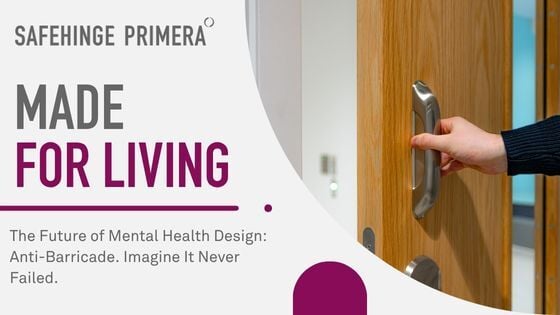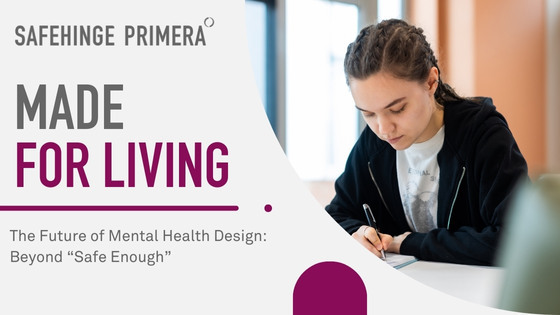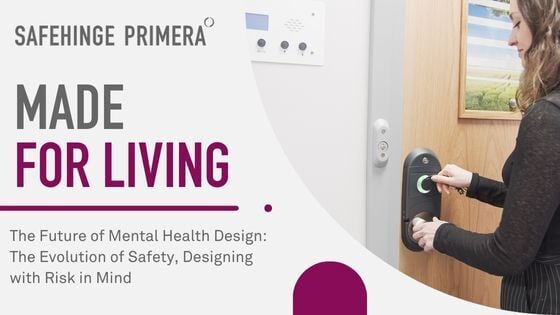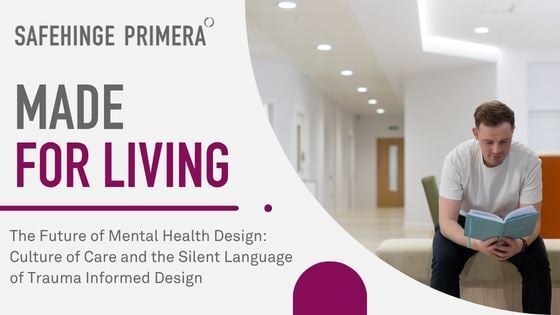How a Joint QI Initiative with Mersey Care Reduced False Alarms by 99%.
When it comes to service user safety in mental health settings, every second counts. That’s why Aspen Wood, Mersey Care NHS Foundation Trust’s new 40-bed low secure unit for people with learning disabilities, installed 67 full-door ligature alarm systems. A door alarm system that invisibly transforms the entire door into a weighing scale, detecting any sustained load and triggering an alert for staff to proactively intervene and save a life.
However, frontline NHS teams using full-door ligature alarms and other door-top and door-edge-only systems shared a challenge: frequent false alarms. These alarms are disruptive, distracting, and desensitising. For staff already stretched, these alerts became a barrier to the calm, therapeutic environments we’re all working to create.
Not one to shy away, we listened. Then we acted together and co-launched a quality improvement (QI) initiative to get under the skin of the issue.

The Cost of Constant Alarms in Mental Health Wards
Imagine being a nurse on a mental health ward where an alarm sounds 10-20 times every day. Each alarm demands immediate attention – a possible ligature attempt – yet almost every time it turns out to be a false alert.
Front-line caregivers were understandably anxious that alarm fatigue – the desensitisation to alarms due to overexposure – could undermine patient safety. The false alarms were also distracting staff from providing care.
Alarm fatigue is not a trivial inconvenience; it’s a well-documented clinical risk. In healthcare settings, when clinicians face an overload of alarms, they can become desensitised, leading to slower responses or ignored alerts¹. In the context of mental health, the stakes are especially high – an ignored alarm could mean a completed suicide. Recent findings in the UK have highlighted this danger: an NIHR review noted that “‘alarm fatigue’ associated with surveillance technology use can even have fatal consequences²”. Tragically, this was echoed by a real-world incident in Essex, where an 18-year-old patient was found unresponsive after staff failed to respond for over 52 minutes to a bathroom sensor alert. The inquest revealed that staff had grown so accustomed to frequent alerts on their digital monitoring system that “alert fatigue” had set in³ bbc.com.
Aspen Wood’s Alarm Challenge: 600+ Alerts and a Team Determined to Help
At Aspen Wood, the alarm overload soon after installation quickly became recognised as an urgent patient safety and operational issue. The Trust’s leadership moved swiftly, bringing us in to discuss the issue and creating a cross-functional working group to explore ways to resolve it.
Around the table were clinicians from the wards, Estates managers, the Trust’s risk and patient safety leads, Safehinge Primera's team of experts, who developed the full-door anti-ligature alarm, and Pinpoint, who provide the staff attack alarm system that relays door alerts to staff devices. This collective approached the problem seeking to understand the issue in greater detail and exploring a range of means to improve.
Everyone agreed on a critical point: expecting zero alarms wasn’t realistic, but we should aim to get as low as possible (there will always be some incidents or tests). The team set an initial target: roughly one ligature alarm per day across Aspen Wood – ambitious yet attainable with the right improvements.
.jpg?width=1750&height=781&name=Email%20Header%201%20(5).jpg)
Collaborative Problem-Solving: Firmware Enhancements, Weight-Sensitivity Tweaks, and Improved Staff Training
Several concrete solutions emerged from the discussions and subsequent development work:
- Adjusted Sensitivity Threshold: When the QI team discussed weight sensitivity, the Trust’s Risk team highlighted that the door alarm was much more sensitive than other safety devices within the room - the load release curtain tracks released around 20 kg. The full door alarm was set to a 7 kg weight threshold, unnecessarily sensitive. Here, the adjustable weight threshold became a big advantage for the Trust, changing to 15 kg for this user group (with the benefit of keeping lighter weight sensitivity when used for people with eating disorders). This change sharply cut false positives without compromising safety (indeed, the team carried out a series of lab tests based on a range of different previous ligature attempts).
- Firmware Enhancements & Battery Life: Safehinge Primera also rolled out new firmware that greatly improved battery life. The new firmware also introduced smarter data logging – essentially enabling the system to be more “intelligent” about what triggered it, so that staff could get feedback if improper use of the door was causing alarms (like wedging the door open or hanging objects). These behind-the-scenes tweaks enhanced the system’s robustness and reduced nuisance triggers by providing helpful feedback for staff. These insights are also being funnelled into future firmware developments, which is updated over-the-air regularly to continually bring improvements to all customers who use the door alarm - always getting better.
- Localised and Silent Alerting: Initially, a door ligature alarm at Aspen Wood would broadcast an alert across the entire hospital network via the staff attack alarm system. This meant a single bathroom incident could set off alerts on multiple wards, needlessly alarming staff beyond the affected area. At Mersey Care’s request, Pinpoint reconfigured the system so that door ligature alarms now alert only the local ward. This change empowers the ward staff to quickly verify and respond, and, if it is a serious incident, staff can still escalate using their PIT alarm. The result is fewer interruptions hospital-wide and a more scalable response protocol. The Mersey Care team had always opted for silent alarms to prevent disrupting service users with learning disabilities, an approach we’re seeing adopted nationally across all care pathways.
- Staff Training Refreshers: The Trust and Safehinge Primera co-created simplified support materials to ensure staff felt confident managing the alarm system. A quick-reference poster was designed (with input from Aspen Wood’s clinical team) to support new or bank staff on how to swiftly reset a door alarm after an incident. Training sessions were scheduled, including hands-on practice using Safehinge Primera’s mobile training unit - Doora. This conscientious approach acknowledged that technology is only as effective as the people using it.
- Stronger Interface & Support: Both Safehinge Primera and Pinpoint also recognised that closer integration and joint support when complex technical issues arise would help Mersey Care’s Estates team resolve issues quickly and easily. The two suppliers also worked together to create a joint troubleshooting guide for the Aspen Wood team, so any issues could be quickly pinpointed (no pun intended) and resolved. By improving the interface between the two systems and clarifying responsibility, the Trust gained confidence that “issues” would no longer fall into a void between different suppliers, but instead, a collaborative team of experts.
Results: From 600 Alarms to just 6 – A Transformative Difference
The results were even better than we’d hoped for…not 30 alarms per month, but just 6 alarms. When the stakeholders reconvened at the end of April 2025, Safehinge Primera’s door alarm dashboard evidenced that alarm rates had plummeted. This has restored the alarm system to its intended role: a trusted safety aid, not a constant distraction.
.png?width=1046&height=632&name=image%20(19).png)
Reliability through the system's continual monitoring (avoiding the costly daily check requirements from push-bar, door edge type alarm systems) and adjustable weight sensitivity meant the alarms were keeping staff focused on time to care, whilst ensuring service user safety too.
A Model for Best Practice: Hopeful Lessons Beyond Aspen Wood
The journey at Aspen Wood carries hopeful lessons for mental health facilities everywhere. Alarm fatigue in an inpatient mental health setting is not an insurmountable fate; it’s a challenge that can be overcome through empathetic, curious, and determined collaboration. Mersey Care didn’t shy away from flagging the problem, and in partnership with Safehinge Primera and Pinpoint, they created the space to carry out deep root cause analysis and co-create solutions. The outcome made the alarm smarter, more user-friendly, and tailored to the ward’s needs. In doing so, they upheld a core principle of patient safety: technology must augment, not hinder, the human care process.
This story also underlines a broader point in NHS mental health services: collaboration and continuous improvement are key. Just as we strive to co-produce care with service users, here we see collaboration between clinicians, engineers, and estates teams. The result – a dramatic reduction in alarms and a safer, calmer ward – speaks to the power of being conscientious (putting service user and staff needs first) and determined (not giving up on a good idea, even when it hits bumps in the road). By staying curious (asking “Why is this happening? How can we fix it?”) and maintaining a positive mindset that a solution would be found, the Aspen Wood team exemplified the best of NHS innovation culture.
Looking ahead, Mersey Care’s Aspen Wood can serve as a model of best practice that we’re actively rolling with other mental health Trusts. The improvements made – smarter firmware, adjusted weight thresholds, better training, and cross-system communication – are broadly applicable to any site using the advanced intelligent safety alarm systems.
.jpg?width=1260&height=563&name=Email%20Header%201%20(7).jpg)
We’ve also got a number of collaborative QI Initiatives with mental health Trusts who already use our products. The end result is a safer environment where staff can do what they do best – provide compassionate, attentive care – with technology as an ally rather than a hindrance. In the words of Safehinge Primera’s ethos, it’s all about designing for good and helping protect people through their most vulnerable times. The Aspen Wood initiative shows that when we listen, learn, and refuse to give up, we can make things better together.
Sources:
- HSSIB – Investigation into staff fatigue and patient safety (contextual definition of alarm fatigue) hssib.org.uk
- Griffiths et al., 2024 – Surveillance technology in mental health inpatient settings (medRxiv preprint) (alarm fatigue can have fatal consequences) medrxiv.org
- BBC News – Essex mental health patient died despite staff alarm – inquest (case highlighting alert fatigue in a mental health unit) bbc.com
- Mersey Care NHS – Aspen Wood Full Door Ligature Alarm Review (Quality Improvement Initiative)
➡️ Book a product demo with Doora
➡️ Watch our joint webinar with Mersey Care
➡️ Download the Full Door Ligature Alarm brochure
Contact us to discuss your challenges and how we can help on your next project.




